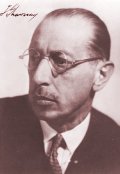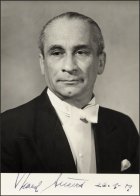
Igor Stravinsky
The three pieces on this disc are programmed with relative rarity for a number of reasons, but one key reason is Stravinsky’s progression, through a long and fruitful career, towards greater concision. When Stravinsky started out, his dominant influences were the rich orchestration of his teacher, Rimsky-Korsakov, and the sonic shadowlands of Debussy (Andrei Rimsky-Korsakov once dismissed
Petrushka as a concoction of “Russian vodka with French perfume”). Later, though, Stravinsky tended (in such scores as his ‘ten-minute concerto,’ the Movements for Piano and Orchestra) towards a kind of ‘miniaturization,’ finding some resonance with the music of Webern, to which Robert Craft introduced him in the early 1950s. The Cantata and Mass are too demanding to be taken up casually by a passing tenor, or your average choir; and their accompanying ensembles are at once too small to occupy a symphony orchestra, yet large enough to require special assembly.
When he began composition of
Svadebka (
Les noces), at about the time of
Le sacre du printemps, Stravinsky’s idea of the accompaniment at first was something in line with the large orchestra of his other ballets at the time. Gradually, his changing conception of the orchestration became sparer, until at last the instrumental complement consisted of four pianos and percussion. The curious thing is how this reduced ‘orchestra’ in
Les noces is actually the fullest ensemble among the three pieces on this wonderful reissue by Supraphon.
Les noces is a masterful balance between affectionate regard for tradition (and in this case, both folk and musical tradition) and innovation. Stravinsky delighted in the instrumentation for its being “totally homogeneous, totally impersonal, and totally mechanical” — a kind of ‘industrial’ sonic reaction against lush Romanticism, a reaction soon to reach flower in the
style mécanique. The opening page of Les noces uneasily joins the brittle sound of xylophone and the upper reaches of the piano (such ‘dry’ strings that the four pianos are a practical sonic necessity for mutual reinforcement), with the sustained, keening lament of the bride-to-be as her long tresses are trimmed — a symbol of the passage from girlhood, from the comfort of the home she grew up in, to the mysterious journey of wedded life.
Yet, if that opening passage is an effective exploitation of the sonic contrast of the ‘impersonal, mechanical’ instruments against the voices, in other passages Stravinsky can make even these mechanical instruments to sing in support of the voices: the duet between the bride-to-be (soprano) and her mother (tenor) near the end of the first scene (“Braid my hair aright”); the bittersweet lament of the two mothers (soprano and mezzo) in the third scene (“Dearest child whom I brought into this world and nursed”). And of course the ensemble’s percussive character brilliantly imitates that iconic Russian sound, the church bell, in the luminous love-song of the groom (bass), which concludes the ballet. This page alone would make the score one of the landmarks of Western music; when Stravinsky played it through for Diagilev in 1915, the impresario wept, saying that
Les noces would “make the most beautiful and most quintessentially Russian creation of our ballet.”
For his Mass, Stravinsky disregarded the example of such grand, monumental settings as the Bach Mass in B Minor and the Beethoven
Missa Solemnis, and set the Ordinary within modest, liturgical dimensions. Indeed, his hope was that it might be used liturgically. Even before the second Vatican Council, though, it would have been rare to find a basilica prepared to field a group of those ten winds. As in the Symphony of Psalms, Stravinsky inscribes the score of the Mass with a preference for boy trebles; and not many a diocese, probably, can boast a boy’s choir equal to such a piece.

Karel Ancerl
Designed for church use, the music is of some 17 minutes’ total duration. The accompaniment is scored for double wind quintet; the wind writing is a clear descendant of the Symphonies of Wind Instruments, and the scoring is a classic example of Stravinsky’s ability to select a novel combination with a strikingly ‘right’ profile. The five woodwinds are all double-reeds (two each of oboe and bassoon, one English horn); and all the brass are cylindrical-bored (trumpets and trombones). Absent are such characteristically ‘warm-toned’ instruments as the clarinet, and the French horn.
The Cantata is the latest work of these three. Some conductors make rather too much of underscoring a similarity to Webern — and then, this recapitulates an image problem, in that Webern has been made a poster-child of the post-War avant-garde, to a degree which is at curious odds with Webern’s own musical taste. It is a great fault to make of Stravinsky’s Cantata, an exercise in dryness of aesthetic (just as it is a fault to perform this operation upon Webern); a fault which, happily, Ancerl avoids with all apparent ease.
Parallels quite naturally suggest themselves between some of Stravinsky’s late works and the music of Webern, but Stravinsky’s Cantata starts out with some striking differences. Both the Webern Cantatas are scored for orchestra — not your full, late-Romantic-era orchestra, but still a sizeable ensemble. Stravinsky’s accompaniment is only five instruments: two flutes, oboe, English horn (doubling second oboe) and cello; a warmly pastoral sound. Webern set poems written by his friend Hildegard Jone; Stravinsky selected antique English texts — following Britten’s example already? (The librettist for
The Rake’s Progress was Auden, a personal friend of Britten’s.)
The centerpiece of the Cantata is the tenor solo, “Tomorrow shall be my dancing day,” a compositional tour-de-force which plays all manner of ingenious contrapuntal tricks. Sinuous pitch-work, ‘hiccoughing’ rhythms, and long interlocking phrases (which leave the tenor scarcely any room to draw breath) make this ten-minute-plus aria a supreme challenge for the singer. Gerald English in this recording displays wondrous mastery; he has not only learnt the notes, but brings music forth from them.
This disc is excellent musical value. Apart from first-rate readings of
Les noces and the Mass, this account of the seldom-recorded Cantata is exemplary.
~Karl Henning
http://members.tripod.com/~Karl_P_Henning/
Please support Good-Music-Guide.com
by purchasing this CD using this link.

Track Listing
Igor Stravinsky
Choral Works
Libuše Domanínská, soprano
Marie Mrázová, contralto
Ivo Žídek, tenor
Dalibor Jedlicka, bass
Barbara Robotham, soprano
Gerald English, tenor
Prague Philharmonic Choir
Members of the Czech Philharmonic Orchestra
Karel Ancerl, conducting
Supraphon 3692-2 211
1. Les Noces I (The Wedding)
Ballet in 4 tableaux for vocal soloists, chorus & orchestra
Igor Stravinsky
Performed by Libuse Domaninska, Dalibor Jedlicka, Marie Mrazova, Peter Toperczer, Zdenek Kozina
Conducted by Karel Ancerl
2. Mass, for chorus & double wind quintet
Igor Stravinsky
Conducted by Karel Ancerl
3. Cantata, for two soloists, female chorus, & chamber orchestra
Igor Stravinsky
Performed by Gerald English, Barbara Robotham
Conducted by Karel Ancerl